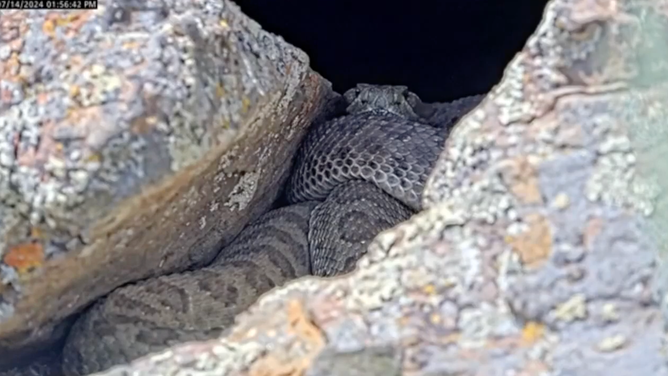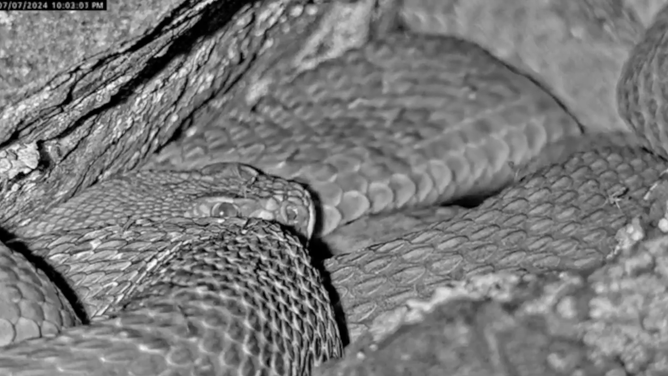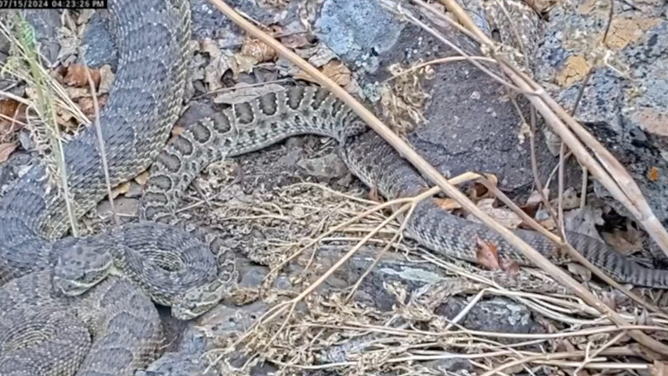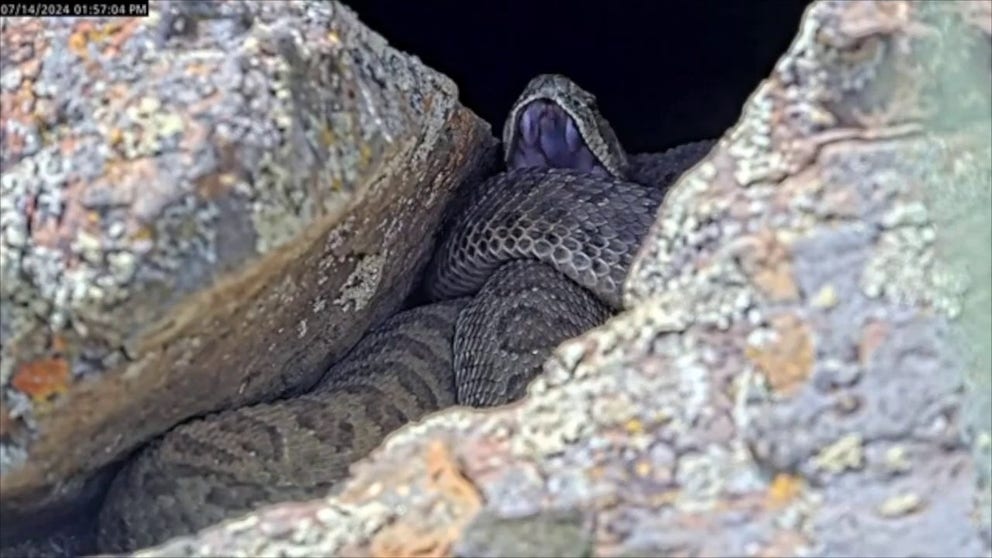Watch: Pregnant rattlesnakes slither over each other in Colorado ‘mega-den’
Project RattleCam, a community science project led by California Polytechnic State University, recorded the pregnant rattlesnakes video as part of their livestream.
Pregnant rattlesnakes slither over each other in Colorado 'Mega-Den'
A recent video shows images of wild prairie rattlesnakes in a Colorado den that is home to hundreds of the slithering reptiles. (Courtesy: Project RattleCam via Storyful)
A recent video shows images of wild prairie rattlesnakes in a Colorado den that is home to hundreds of the slithering reptiles.
The video contains three clips of rattlesnakes, all recorded within the past couple of weeks.
It starts with a close-up of a snake as insects scurry across its scales and over an eyelid.
Next up is a shot of at least three rattlesnakes sitting upon rocks and leaf litter. One of the snakes can be seen shedding its skin as it slithers past the two other snakes and then hides under a rock.
The last clip shows a lone snake peacefully curled up between two rocks, letting out a couple of gentle yawns.
Learning about rattlesnake mothers

Yawning rattlesnake.
(Project RattleCam via Storyful / FOX Weather)
The footage was recorded as part of a livestream run by Project RattleCam, a community science project led by California Polytechnic State University, as a way for researchers to learn about the reptiles.
"This livestream allows us to collect data on wild rattlesnakes without disturbing them, facilitating unbiased scientific discovery," said Emily Taylor, Project RattleCam lead and a Cal Poly biological sciences professor.
STAYING SAFE INDOORS AND OUTDOORS DURING RATTLESNAKE SEASON
One aspect researchers are hoping to learn about is the social behavior of the rattlesnakes, specifically the pregnant females.
This mega-den contains up to about 100 pregnant females, as most of the males have left to forage for the summer, according to Professor of Biology at Dickinson College Scott Boback.
"The females forego eating all summer long," Boback said. "They are using only stored fat accumulated over the past year or two and devoting that to their babies."

Rattlesnake peers at camera.
(Project RattleCam via Storyful)
Those babies, or pups, are expected to be born starting in August, according to a statement by Cal Poly. They will be born live and helpless rather than be born from eggs.
One of the behaviors Boback and his team will study is how the female prairie rattlesnakes interact once their pups are born.
In some species of rattlesnakes, not only will the pups' mother protect them for two weeks, but a nearby mother who hasn't yet given birth will also protect those pups. Whether this occurs with prairie rattlesnakes is yet to be determined.
Additionally, Boback noted that some species are known to have their females aggregate in smaller groups with individuals that are closely related to them.
"Like sisters or aunts or maybe a grandmother," he said.
By watching footage captured during the livestream, Boback and his fellow researchers hope to understand whether the pregnant females in this prairie rattlesnake mega-den are aggregating for the same purpose.
They also hope to observe the pups' direct interactions with other animals.
How the public can watch the rattlesnake livestream

Insect crawls over a rattlesnake.
(Project RattleCam via Storyful / FOX Weather)
In addition to researchers, the public can also view the livestream, which is hosted on YouTube. According to Cal Poly, public viewers have reported views, such as rodents crawling over the snakes and a large number of snakes emerging from the Colorado den to drink raindrops that collected on their scales.
The public’s views have even helped scientists identify snakes by their unique scale patterns.
Taylor said that providing the public with views of rattlesnakes behaving naturally may help fight the "biased imagery" of the reptiles seen on television, which often shows the animals in a stressed, defensive state after being provoked by humans.

Rattlesnakes slither by each other.
(Project RattleCam via Storyful / FOX Weather)
Livestream viewers will be able to see the birth of rattlesnake pups in August. The pups will remain in the den with their mothers until male snakes return in September for hibernation. According to Cal Poly, the livestream will then be turned off for the winter and then turned back on during the spring.
WHERE DO SNAKES GO IN THE WINTER?
They noted that this mega-den of rattlesnakes is a rare habitat, as its geologic features provide the snakes with hiding places and shelter from the elements.
The best times to watch the rattlesnakes are in the morning and early evening, they added.
Along with the Colorado livestream, Project RattleCam launched a second livestream of a smaller rattlesnake den in California. It can also be viewed on the project’s YouTube page.
Boback said the cameras operated remotely so the dens and snakes they are recording are not impacted by human presence. He noted that their locations are undisclosed to protect the snakes.
